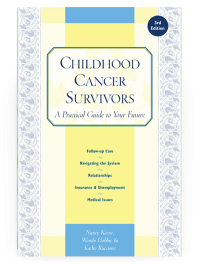Childhood Cancer Survivors
Exercise
Regular exercise helps you look better and feel better. It helps your heart work efficiently, helps your muscles and bones stay stronger, and keeps your brain agile. It can also reduce depression. Briskly walking for 30 minutes a day can make remarkable changes in your level of health.
I had both eyes removed when I was 2 because of bilateral retinoblastoma. My mom always told me I could do whatever I wanted. She enrolled me in tap dancing when I was 4. She later read in a magazine that roller skating was good for blind children’s balance. My sister was already a roller skater so she asked the coach if he would teach me also. I started skating when I was 7. We went on to the competitive level and later qualified for the junior Olympic nationals.
When picking what exercises to do, choose things you enjoy. You are much more likely to stick with something fun. Exercising with a friend also helps make the time pass quickly and more enjoyably.
I had scoliosis prior to my Hodgkin’s diagnosis, and never followed up on it because of the cancer. Now, 10 years later, I have a lot of back pain, and I’ve had to follow a pretty rigorous exercise program designed by a physical therapist. I work out with weights 3 times a week, and I do aerobics (swimming, walking) 6 days every week. I do mostly swimming, though, because it is something I enjoy so it’s easier to stick with for the long run.
We have a saying in my family: Shoulda, woulda, coulda. I’m 30 pounds overweight and not doing a thing. I have a NordicTrack ® right here which is a great clothes hanger. I went in and had a stress echocardiogram and I was fine, but I am starting an exercise program through the wellness program at work. I’m going to use the treadmills and start a low-fat diet. I also like to cross-county ski and bicycle. I know, though, that the theory is great, but the implementation is hard.
• • • • •
My favorite time of year is autumn. Our hills aren’t covered in colors, but I like the crisp air so I never have trouble motivating myself to go outdoors whether the sun’s out or not. Usually once I get out the door, I go for 5 or 6 miles. I enjoy the quiet time for personal reflection, and the exercise makes me feel good mentally.
I wear a Walkman ® with rock and roll to keep my pace. I started by walking around the block and built up the distance over a period of years. Walking increases aerobic fitness of your heart, lungs, and circulatory system. It strengthens muscles in your lower body, helps control weight, and improves sleep, mood, and resistance to cold and heat. It doesn’t cost anything. It’s easy to do any time of day. Once you do it for 3 weeks, it becomes routine.
If you are at risk for heart problems, or you have another physical limitation, exercise can make a big difference in your long-term health. Incorporating exercise into your life can help you stay healthier as well as feel better. One way to start exercising more is to use a pedometer (a device that you strap on your leg, wrist, waistband, or access on a smartphone) to learn how many steps you are taking every day; then set reasonable goals to increase the number of steps you take each day. Before starting an exercise program, check with a healthcare provider experienced in follow-up for survivors of childhood cancer.
My main concern is my heart. I work out religiously. Part of it is to keep my sanity, but the major part is to keep my health and youth. I want to enjoy my family and friends for as long as I can. Your heart can go to pot if you don’t take care of it. I used to swim competitively before cancer and I’ve continued to swim and run every day.
For reasons that are not well understood, many survivors (especially those who had cranial radiation at a young age) exercise less than other people their age. Researchers who recently reviewed 26 studies on diet and exercise in survivors stressed the importance of interventions to increase the physical activity of survivors. 1
Table of Contents
All Guides- 1. Survivorship
- 2. Emotions
- 3. Relationships
- 4. Navigating the System
- 5. Staying Healthy
- 6. Diseases
- 7. Fatigue
- 8. Brain and Nerves
- 9. Hormone-Producing Glands
- 10. Eyes and Ears
- 11. Head and Neck
- 12. Heart and Blood Vessels
- 13. Lungs
- 14. Kidneys, Bladder, and Genitals
- 15. Liver, Stomach, and Intestines
- 16. Immune System
- 17. Muscles and Bones
- 18. Skin, Breasts, and Hair
- 19. Second Cancers
- 20. Homage
- Appendix A. Survivor Sketches
- Appendix B. Resources
- Appendix C. References
- Appendix D. About the Authors
- Appendix E. Childhood Cancer Guides (TM)

